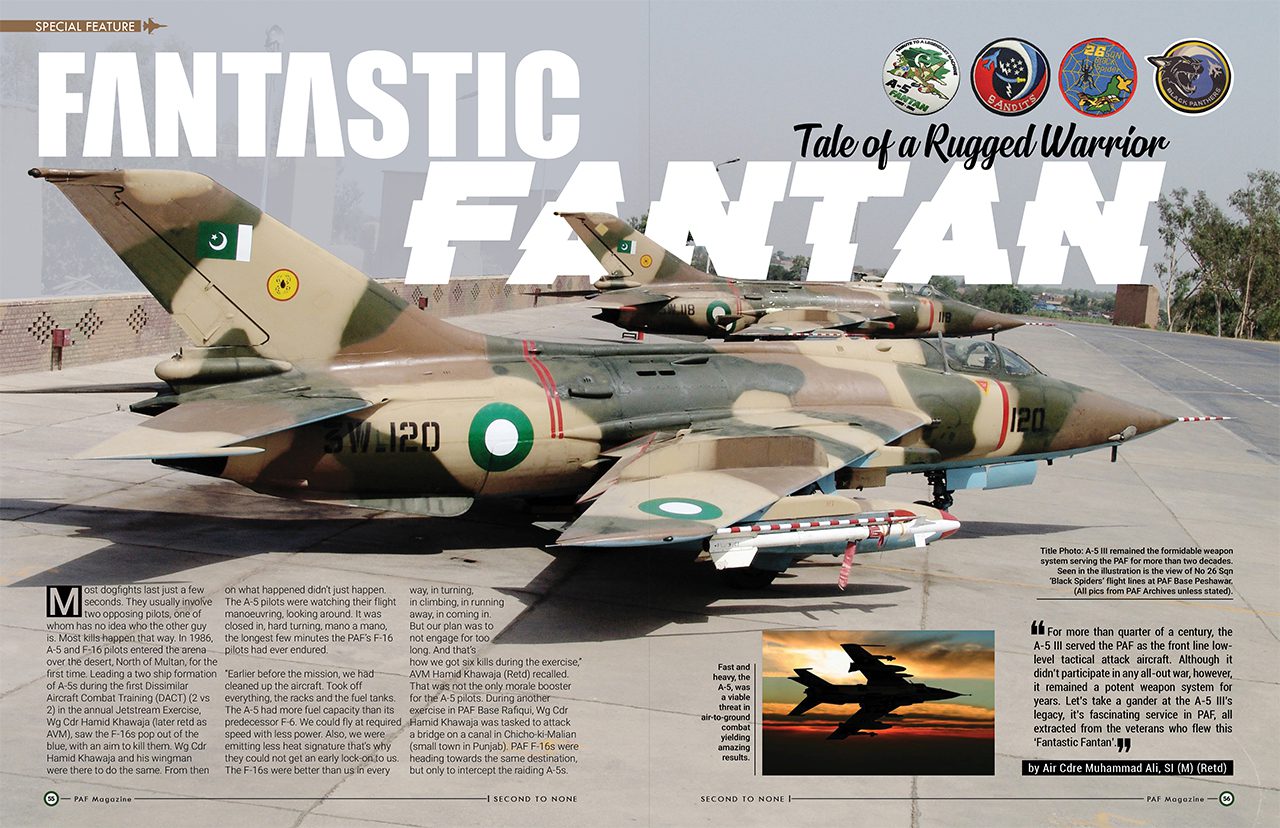For more than quarter of a century, the A-5 III served the PAF as the front line low-level tactical attack aircraft. Although it didn’t participate in any all-out war, however, it remained a potent weapon system for years. Let’s take a gander at the A-5 III’s legacy, it’s fascinating service in PAF, all extracted from the veterans who flew this ‘Fantastic Fantan’.
Most dogfights last just a few seconds. They usually involve two opposing pilots, one of whom has no idea who the other guy is. Most kills happen that way. In 1986, A-5 and F-16 pilots entered the arena over the desert, North of Multan, for the first time. Leading a two ship formation of A-5s during the first Dissimilar Aircraft Combat Training (DACT) (2 vs 2) in the annual Jetstream Exercise, Wg Cdr Hamid Khawaja (later retd as AVM), saw the F-16s pop out of the blue, with an aim to kill them. Wg Cdr Hamid Khawaja and his wingman were there to do the same. From then on what happened didn’t just happen. The A-5 pilots were watching their flight manoeuvring, looking around. It was closed in, hard turning, mano a mano, the longest few minutes the PAF’s F-16 pilots had ever endured.
“Earlier before the mission, we had cleaned up the aircraft. Took off everything, the racks and the fuel tanks. The A-5 had more fuel capacity than its predecessor F-6. We could fly at required speed with less power. Also, we were emitting less heat signature that’s why they could not get an early lock-on to us. The F-16s were better than us in every way, in turning, in climbing, in running away, in coming in. But our plan was to not engage for too long. And that’s how we got six kills during the exercise,” AVM Hamid Khawaja (Retd) recalled. That was not the only morale booster for the A-5 pilots. During another exercise in PAF Base Rafiqui, Wg Cdr Hamid Khawaja was tasked to attack a bridge on a canal in Chicho-ki-Malian (small town in Punjab). PAF F-16s were heading towards the same destination, but only to intercept the raiding A-5s. The then Squadron Commander, Wg Cdr Hamid Khawaja, had put together two packages of four Mirages and six A-5 IIIs. He planned it such that the F-16 pilots went chasing in the wrong direction, enabling the A-5 pilots to complete their mission and escape. Later, this episode did upset a lot of people in the F-16 squadrons, but this is what the nature of this challenging profession is like.
A curious feature of the A-5 history was its reputation as the leading ground attack jet despite its inferiority (with respect to performance) compared with other fighters in the PAF inventory of that time. Over the years, PAF pilots, engineers and maintenance crew developed a kind of love and hate relationship with this rugged warrior owing to its diverse characteristics. That’s why it deserves a rightful place in the history of PAF as one of the potent weapon systems that served the nation for more than two decades.
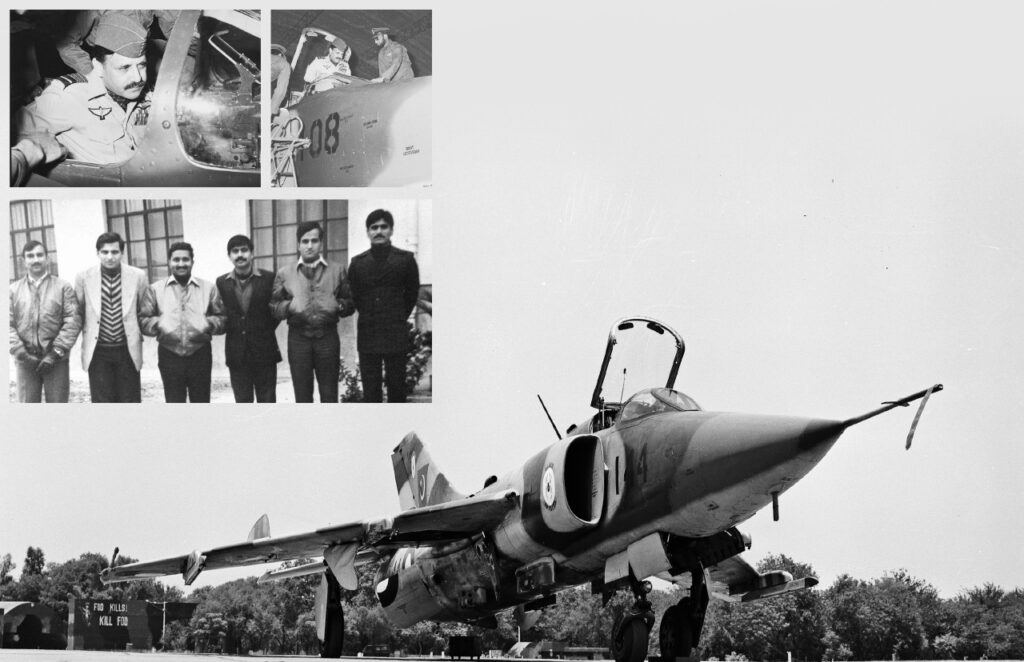
While the Chinese A-5 achieved fame on the strength of several outstanding attributes, of these, perhaps the most important was its excellent low level capability. “The more it hugged the ground at high speeds, the more stable it used to become compared with other jets in the PAF’s fleet. The A-5 was excellent in the ground attack role,” reminisced AVM Sajid Habib (Retd). To these attributes were added, a heavy offensive weaponry, though the true combat potential of the A-5 was achieved only after a long period of gestation.
Back in the 1997-98, Wg Cdr Sajid Habib was the officer commanding of Sqn No 16 ‘Black Panthers’, which was equipped with A-5 IIIs at that time. Under his command, ‘Panthers’ won the ACES trophy for the second time. That year, the No 16 Sqn, also scored Alpha every month in every exercise in live bombing and strafing. The sqn achieved the same feat almost a decade ago, when it won the ACES trophy for the first time under the command of Wg Cdr Zafar Mirza in 1989-90. From there on there was no looking back. The A-5s earned their reputation and its pilots performed outstandingly in all exercises armament competitions and fire power demos.
The Pioneers
Ferries of the A-5s from Nanchang, China commenced in the summers of 1983 and continued till mid of 1984, without the laborious and costly land hopping routine, which the PAF pilots experienced while ferrying F-6s almost a decade ago. The first six aircraft were delivered on 12 February, 1983, under the command of Wg Cdr Hamid Saeed Khan and his seven colleagues, Wg Cdr Farooq Siddique, Sqn Ldr Mansoor Ahmed, Sqn Ldr Saeed Akhtar, Sqn Ldr SA Muddassir, Flt Lt Altaf Saleemi, Flt Lt Saifoor Ahmed and Flt Lt Ahmed Yar Khan. The ferry engineering officer was Sqn Ldr Asfar Majeed. Another six were delivered to Pakistan four days later. All-in-all 54 dual-engine A-5s were ferried from China in the coming months.
A young Flt Lt in 1982, Sajid Habib was also among the pioneering pilots who went to Nanchang, China to complete ground training course on A-5 IIIs. “By comparison, the A-5 was unusual looking. Our reaction was, what is that?’’ Perhaps, a cross between Mirage and F-6,” AVM Sajid Habib (Retd) remembered with a smile. Accompanying him during the course were Flt Lt Hanif, Sqn Ldr Saeed Shahi, Flt Lt Altaf Saleemi, Flt Lt Khawaja Latif. Wg Cdr Hamid Saeed Khan was the contingent commander. “These were the difficult times, as none of the locals could speak and understand English. Even the A-5 dash-one and checklist were in Chinese which made our lives miserable, however, Flt Lt Saleemi did a great job in translating all the procedures into English,” remembers AVM Sajid Habib (Retd).
Mocked initially, the A-5’s fuel capacity was incredible. “It could fly farther than an F-6 fitted with fuel tanks. The first A-5s flew direct from Hotian to Rafiqui Air Force Base, at 34, 000 ft, with some 1, 300 litres fuel to spare after we landed,” added AVM Sajid Habib (Retd), who carried out his first ferry in one go.
Re-Equipments
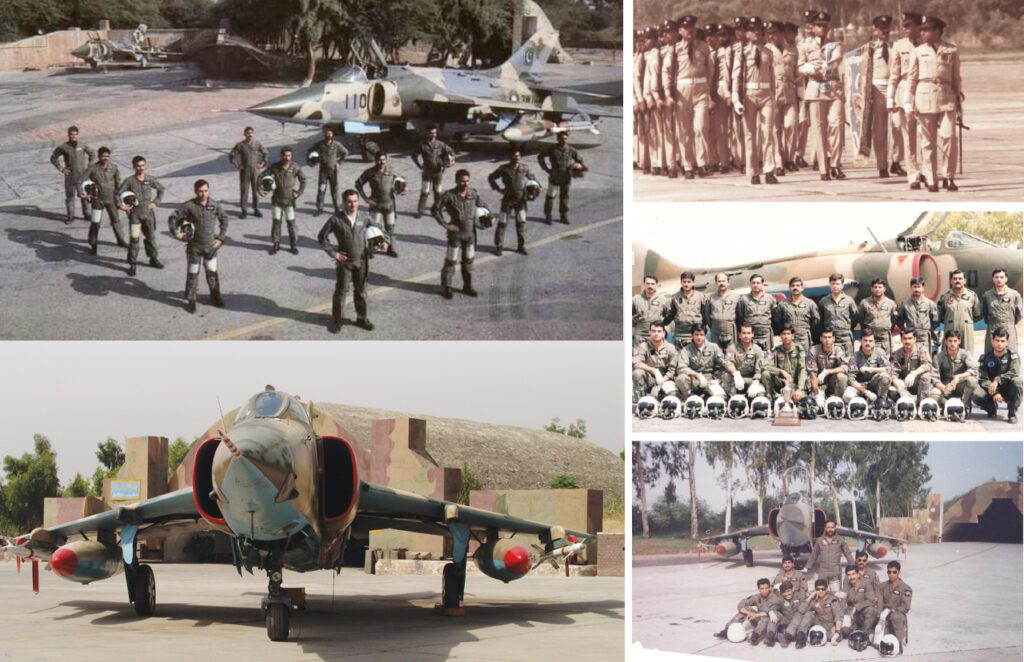
No 16 Sqn, the ‘Black Panthers’ was the first sqn of the PAF to be equipped with A-5 III. The re-equipment ceremony was held on 21 March, 1983 wherein General M Iqbal, Chairman Joint Chiefs of Staff Committee was the guest of honour. Wg Cdr Hamid Saeed Khan was its first sqn cdr. During the ceremony, Wg Cdr Tahir Ahmed flew his A-5 in an aerobatic demonstration showing off the agility and manoeuvrability of the aircraft. Sqn Ldr Mansoor Ahmed, Sqn Ldr SA Muddassir, Flt Lt Altaf Saleemi and Flt Lt Saifoor Ahmed flew their A-5s in a four ship formation the same day. Two days later, on Pakistan’s Defence Day, another formation of A-5s flew by, led by the Rafiqui Base Commander, Air Cdre Amjad H Khan. PAF was proud to present their newest combat aircraft to the watching world.
Next in line for re-equipment was the No 26 Sqn which got converted on to A-5 IIIs in mid of 1983, under the command of Wg Cdr S Arshad Toor. In 1985, after converting on A-5 IIIs, the sqn won the three top laurels, the Professionals, Flight Safety and Command Armament competition trophy.
No 7 ‘Bandits’ was the last sqn to receive handful of A-5 IIIs replacing the vintage B-57 Bombers. On 27 December, 1983, the re-equipment ceremony of the squadron was held at PAF Base Rafiqui, with Wg Cdr Shams Khan as its first sqn cdr. At the same time, the sqn was also re-assigned the new role as the ‘Tactical Attack Squadron’. At the end of the ceremony, two B-57s in close line astern position flew past the venue indicating end of their valuable service to PAF. Moments later, in came the agile and sleek A-5s in close ‘vic’ formation.
The Backdrop
PAF pilots argued that the A-5 did not distinguish itself on any major event but flew with somewhat equal distinction. It did well over the mountains as well as over the southern desert. Its cosmopolitan nature was fundamental in its design, its origins much to the previous wars and subsequently to the urgent need to re-equipment by the PAF during 80s. And even though the A-5s were inducted around the same time as the F-16s, the numbers of ‘Fighting Falcon’ delivered to Pakistan were insufficient, against an enemy air force four times its size. The Swedes had declined to sell Pakistan their Saab 105s and the PAF had refused the A-7 offered by USA. The dangerous signals after the 71 war followed by a decade long Afghan war had not been ignored by the PAF high command, which was continuously considering the future requirements for the air force. The search took on a new urgency and the PAF once again turned to the Chinese, who readily came up with the Nanchang A-5 III. Well suited to the low level attack role, the A-5 was adaptable and extremely potent. Despite its limitations, it was to serve the PAF valorously in the coming decades.
In the winters of December, 1983, another 17 A-5 IIIs that joined the PAF fleet were equally split between No 16 and No 7 squadrons. The final delivery of some 13 A-5s, should have commenced in China on 19 January, 1984. Bad weather meant that the 14 pilots led by Rafiqui Base Commander Air Cdre Saeed K Kamal, were all delayed at Hotian before the aircraft got to Rafiqui.
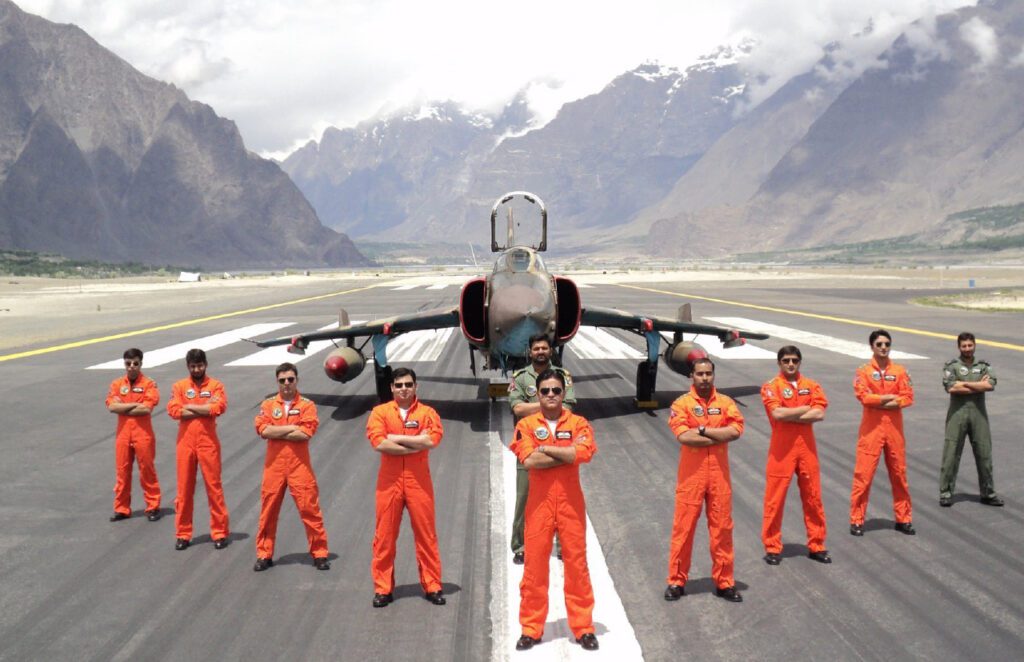
Gp Capt Wali Mughni (Retd), who was then Squadron Commander of No 26 Sqn, remembers an incident of his life which was difficult for him to shake away. In the winters of 1984, he along with his contingent flew to China to test-fly the newly selected A-5-III. Day after their arrival heavy snow started and continued for next 21 days. “Those were very hard days, we were stuck in our rooms and heavy snow didn’t allow us to go outside,” remembers Gp Capt Wali Mughni (Retd). It cleared off on 22nd day and we desperately went to airport to carry out the test flight. Just after take-off, Wg Cdr Wali Mughni broke cloud cover at 2, 000 ft, and performed the necessary checks. He found the aircraft in perfect shape and threw it around to check the various systems. Accomplishing the mission, it was time to land. “As soon as I descended the runway had disappeared under fresh snowfall. The weather changed all of sudden without my expectations. Chinese ground staff frantically tried blowing the snow away using F-6 jet engines mounted on trucks,” recalled Gp Capt Wali Mughni (Retd). By the time they reached the end of the runway, the cleared stretch was again covered by snow.
“It was now a matter of pride and honour. To eject or do whatever it takes to land the fighter. In no way I was convinced to abandon the brand new aircraft. I made two attempts for landing, however, could not locate the runway on final approach due to heavy blizzard. Finally, I informed the control tower that I was coming-in for landing for the last time,” Gp Capt Wali Mughni (retd) said, who was by then flying on vapours. As soon as he touched down, his fuel finished completely and the engine flamed out on the runway. It was a close call, however, he managed to save a valuable PAF asset at the end of the day.
The Aircraft
The twin-engine fighter was an improved version of the Shenyang F-6, a Chinese derivative of the MIG-19. But the A-5s stronger wings allowed it to carry more air to ground weaponry. The F-6 was an air superiority fighter-interceptor, with limited air to ground capabilities. The two afterburning WP-6 turbojet engines provided the rugged A-5III, with its necessary propulsion. PAF A-5IIIs were different considerably from the Peoples Liberation Army Air Force (PLAAF) versions, with several design features being introduced to increase the jet’s strike range.
The swept wing A-5 III could carry bombs, rockets and air to air missiles. It had two GSH guns. External fuel tanks could be carried under the wings and rockets were mounted on under wing pylons. There were four belly stations, which could carry Durandals, Rockeye MK 20 CBU, BL-155 CBU or MK 82 and Snake Eye bombs. However, a fully loaded aircraft (2 AAM, 2 Drop Tanks and 4 bombs) performed averagely.
Modifications
There were several modifications done to the A-5, to overcome complexities of flying operations. The bombing mode (CCIP) that existed in the aircraft was tried out but proved to be of little benefit. The sight was depressed to levels where the pilot could not see it unless his helmet was touching the canopy. Nonetheless, by 1987, PAC Kamra had started overhauling the A-5III. Prior to this, the aircraft had to be ferried to China for attention. The year 1988 was the last time the three A-5s flew to China for overhauling and modifications. At PAC Kamra, engineers transformed the A-5 into a force of reckoning. With two wing mounted cannons, and an array of western and Chinese bombs, including the runway busting Durandals and unguided rockets, the A-5III was turned into a lethal weapon system. For interception, the A-5III could call upon both western Matra 550 and AIM-9 sidewinders, as well as Chinese air-to-air weapons. A tactical air navigation (TACAN) system was also installed in 1985. Later, modifications included installation of GPS-100 which proved to be handy during low level tactical attack missions.
The A-5 was believed to be identical to the F-6 but the PAF soon found otherwise. The A-5 was underpowered for the air combat role and most F-6 pilots flying the A-5, treated it as if it was a powerful and agile machine as its predecessor was. Another problem was that the FT-6 trainer was used as a dual seat trainer for the A-5. The FT-6, had a thrust-to-weight ratio of 0.83 compared with the A-5’s 0.68. Moreover, the nose of the A-5, which was meant to house radars, was also much heavier than that of an FT-6. It required more muscle power, given that the jet engines of both aircraft produced the same output. These factors were sometimes overlooked by the newly converted young pilots, leading to some grave consequences.
While it carried more fuel than the F-6, the A-5 was like a cheap but primitive Mirage. “It was incomparable to the F-16. The ejection seat was unreliable and initially we had several unfortunate accidents. Subsequently, the Chinese ejection seats were replaced with zero-zero Martin Baker seats. Another problem was the lack of stall warning. As you approached the stall there was no pre-stall buffet or noise of the turbulent airflow over the canopy. The first indication was the onset of a tip stall causing the wings rock. This was mistaken by many pilots during the initial years as a control problem. The aircraft had not been spin tested and had the same spin recovery procedure as the F-6 which was aerodynamically different,” recalled AVM Hamid Khawaja (Retd). Initially the PAF pilots flying the other weapon systems, underestimated the ‘Fantastic Fantan’. With proper tactics, the A-5 could hold its own against other jets. During exercises, initially, the agile Mirage pilots found it difficult to escape. On the other hand, when being chased, A-5 pilots also found it difficult to lose their tail. The A-5 possessed another performance feature, which enabled it to outpace most contemporary PAF service fighters was that it was difficult to spot. While the F-16 and F-7, if flown well, could get the better of the A-5, AVM Salman Bukhari (Retd), an A-5 veteran who holds the record of flying the maximum number of hours, said that this jet was invisible. “It’s camouflage livery on top and the under surface sky blue paint job made the A-5 III almost from the ground and especially from above when flying high-speed, low-level missions. I remember during exercises, our opponents could simply not spot us from above. It was a feature in which the A-5 had attained greater notoriety than any other weapon in the arsenal,” added AVM Salman Bukhari (Retd), smiling.
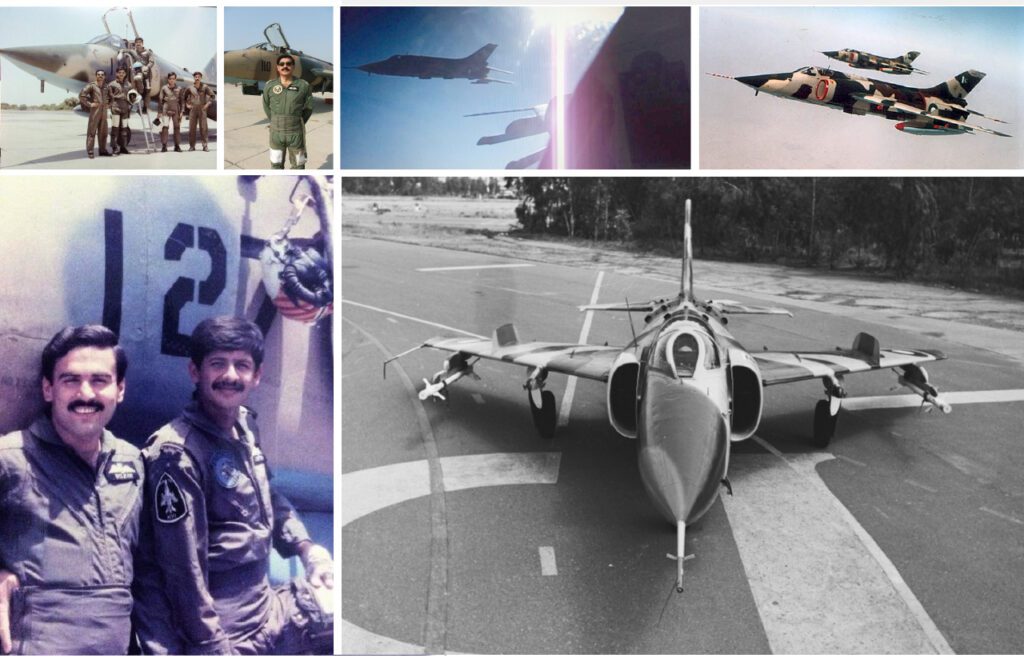
Historically, three PAF squadrons, No 7 Sqn ‘Bandits’, No 16 Sqn ‘Black Panthers’ and No 26 Sqn ‘Black Spiders’ were re-equipped with A-5III aircraft, No 16 Sqn being the pioneer. However, No 7 Sqn was the first A-5 sqn to relinquish the ‘Fantans’ and got converted on to Australian ‘ROSE’ Mirages. The other two sqns carried on with legacy of A-5 till its retirement from PAF service. Initially, PAF Base Rafiqui housed all the three A-5 sqns, however, No 16 and 26 sqns moved to their final destination at PAF Base Peshawar in 1989. Being at Peshawar, the two sqns played an important role on variety of occasions. The sqns participated in all major operational activities and exercises of the PAF, which included Ops Sentinel, Hi-Mark 2005, Saffron Bandit, Banner Towing, Air-to-Air firing camp and DACT at different locations.
Intercepts were a normal part of the policing missions during the Afghan war in 80s and the A-5 was the perfect proving ground for this act. To ensure the sovereignty of the Pakistan air space, the then Squadron Commander of No 26 Sqn, Wg Cdr Wali Mughni, was alerted to get airborne to investigate an aircraft and enforce a no fly zone. Within three minutes, after radars picked up an unidentified aircraft, the sqn cdr was chasing the intruder along with his wingman. On his way, he was informed that a Russian jet had peeled off from 8-ship formation on a bombing run along the Pak-Afghan border. “Being a fighter pilot is an attitude. We used to itch for such an opportunity, to get a kill. But the intruder started waggling the wings of his SU-25 and put his gears down. Obviously we could not engage someone who had indicated to surrender,” Gp Capt Wali Mughni (Retd) recalled. When the pilot was forced to land he remained in the jet for quite some time. When he did step out, everyone on the tarmac was amused. He was a Peshawari-sandals and Shalwar Kamiz wearing chap, with the G-suit on top, a ‘Dari’ speaking defector.
High Altitude Ops
“Deployment to PAF Qadri at Skardu used to be an event, we all waited anxiously throughout the year. It was fun flying there. Weather was good, especially if you are coming from Rafiqui,” remembers AVM Salman Bukhari (Retd). A-5 III was very successful platform for deployment to high altitude airfield like Skardu, which has more than 7000 feet elevation. “Mirages had their peculiar problems operating from high altitude runways and F-6s had limited fuel endurance. All in all, A-5 III was the weapon system of choice when its came to high altitude operations. Flying low in ‘Shigar’ valley and making low level passes over frozen lakes were some of the things you can’t forget,” adds AVM Salman Bukhari (Retd).
Majority of pilots who have flown A-5 are of the opinion that the fuel carrying capacity of A-5 III was phenomenal, perhaps its biggest advantage. “We used to take-off from Peshawar, carry out bombing at a range in Skardu and return. No other aircraft could fly that distance,” said veteran A-5 pilot, AVM Salman Bukhari (Retd), who topped in weapons systems during one of the biggest armament competitions in 1996. AVM Salman Bukhari (Retd), who had flown all PAF jets attributed its success to its stability at low levels, long hauls and weapons carrying capacity.
A-5 pilots have bitter and sweet memories. “It’s never easy to bid farewell to your comrades, especially the ones you have trained for so long. I saw my wingman catch fire and he could not eject. He lies in the vicinity of the runway at PAF Base Rafiqui. May Allah Bless his soul, I still find that very difficult to reconcile,” AVM Hamid Khawaja (Retd) said in a gloomy tone. Some also have sweeter memories. The A-5 squadrons were like springboards for conversion on to more advanced F-16s. It was a norm that the A-5 pilots used to convert directly on the Fighting Falcons. One of the prime reasons was that the pilots were able to fly two-hour missions comfortably, thanks to its impressive endurance. AVM Hamid Khawaja and ACM Sohail Aman along with many others were among those who later converted onto F-16s.
Farewell to Fantan
The year 2007, was the beginning of the end for the A-5s. After serving the nation for more than two decades, the ‘Fantan’ finally gave way to the more agile, state-of-the-art JF-17 Thunder. A-5 III tail number 3W-110, was the first to be retired, the same jet that AVM Sajid Habib flew as a young Flt Lt for the very first time at PAF Base Rafiqui. He was not going to turn down the request to enjoy the last moments in the sky in the A-5, and so had the privilege to fly it for one last time as Base Commander, PAF Base Peshawar.
“The jet flew so smoothly. The credit went to the engineers, who maintained the aircraft so well that not a single needle fluctuated. It was 101 percent serviceable sortie. I along with squadron commanders of No 16 and No 26 Sqns on my wing flew the farewell flight. To record the historical event, I took along my trusted digi-cam for making videos. It was nostalgia, a mix feeling of satisfaction and pride. It was painful to say good bye to a friend with whom you had such a long association,” added AVM Sajid Habib (Retd) recollecting memorable times spent with the aircraft. After a low buzz over the airfield it was time for Air Cdre Sajid Habib to land back amidst the cheering crowds.
The A-5 holds a special place in the PAF’s aviation history. In some respects, the combat career of the A-5 III, was much less spectacular than that of other jets. While it never saw an actual war, it remained in the front line service throughout its tenure. Be it Ops Sentinel, stand-off with India or Kargil war, A-5 was there to defend and respond. A-5 sightings in the air have long gone. The jet now joins the heritage of aircraft collections in the PAF Museum, Karachi. Few of the A-5s are installed at busy crossroads of major Pakistani cities reminding the nation that the ‘Fantastic Fantan’ played its part while defending the aerial frontiers of this sacred motherland.
